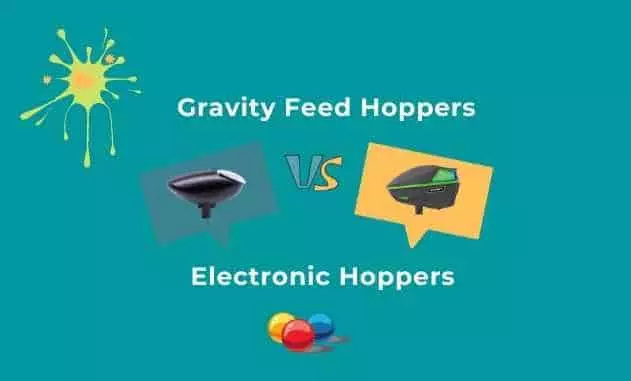
Gravity Fed Hoppers Vs. Electronic Hoppers
Investing in the right paintball equipment could be the magic you need to defeat your opponent on the field of play. One such equipment or gear you need to get right is a paintball hopper or loader. A hopper is a device designed to hold several rounds of balls before discharging the balls to a paintball marker or gun before firing at your opponents. While there are several types of paintball hoppers on the market, gravity-fed and electronic-fed types are the most popular.
This article intends to explain the major differences or similarities between these two paintball hoppers. We believe the knowledge you will gain from this article will strengthen your decision-making abilities towards looking for the best paintball hopper. But before we go too far, let’s quickly take a look at the four types of paintball hoppers you will find on the market.
Without further ado, let’s get started.

Different Types of Paintball Hoppers
Paintball hoppers are broadly categorized into four groups – the force-fed, agitating, gravity-feed, and stick-feed paintball hoppers. Let’s take a look at each of these categories.
The Force- Fed Paint Hopper Or Electronic-Fed Loaders
The force-fed paintball hoppers use a belt-powered system or a sophisticated spring-loaded system to propel paintballs into a paintball gun or marker. The type of paintball hopper is very popular among professional players, as the firing speed can help you sustain the level of play. Some come with a digital display showing the numbers of paintballs remaining in the hopper after each firing. Others use cutting-edge technology to continue feeding balls to the gun. This helps to eliminate misfeeding and prolong battery life.
The Agitating Paintball Hopper
The agitating paintball hopper comes with a propeller and fan blades. Similar to the force-fed hoppers, these hoppers have a higher firing speed than the gravity-fed types. However, they can fail to perform on the field of play when they are in contact with moisture.
The Gravity-Fed Paintball Hopper
If you are looking for a decent, simple, and affordable paintball hopper, the gravity-fed hopper is great for you. It has a feed tube, plus a large container, and attaches to a paintball gun for effective firing at your opponents. They can jam up your paintball guns or marker, which is not a good experience when you are on the field of play.
The Stick-Fed Loader
Lastly, we have the stick-fed paintball loader. This category is more compatible with pump-action guns. They come with simple tubes that can hold up to 24 balls for discharging into the firing chamber of a gun. They are further grouped into vertical and horizontal feeds. The vertical-fed type enables gravity feeding; however, they are not too reliable, so the horizontal type is more popular among experienced paintball players. The best way to load the paintball is to rock the marker forward.
Of these four paintball loaders, the electronic-fed and gravity-fed are the most popular. Let’s take an overview of these two paintball hopper types.
Overview Of Gravity-fed And Electronic-fed Paintball Hoppers
These two paintball hoppers practically perform the same function, but their mode of operation is quite different. For gravity-fed hoppers, they vary in design and how they feed balls to the marker or gun.
It attaches to the feed neck and discharges balls into the gun’s breech by gravity. Gravity-fed hoppers feed about 10 to 12 balls per second.
If you want to fire above 12 balls per second, you may end up chopping the balls or shaking your paintball after every shot. To avoid this problem, you need to upgrade to an electronic-fed hopper. And that takes us to electronic-fed hoppers.
Electronic-fed hoppers also come in different designs and have varying features. These hoppers use motorized paddles that are battery-powered to feed a paintball marker or gun with balls for firing. With an electronic-fed paintball hopper, players can expect to fire around 15 to 20 balls, or even more depending on the model. Electronic-fed hoppers also fire faster than the gravity-fed types.
Let’s now go a bit deeper to explain the features, benefits, and drawbacks of using these two hoppers
What is Gravity Fed Hopper?
Out of all the paintball loaders on the market, the Gravity-fed paintball hopper is the most basic and simple to use. The argument around this device is that gravity propels paintballs into the firing chambers when attached to a paintball gun or marker. It doesn’t have any mechanical parts, agitators, motors, or any moving parts. There are different sizes and can hold up to 200 paintballs.
How It Works
Manufacturers of gravity-fed paintballs designed it in such a way that it allows gravity to push balls into the firing chamber of a paintball gun. This would only happen when you attach the hopper to the gun. Gravity-fed hoppers cannot work in isolation, as they need a paintball gun to function properly. Most of the gravity-fed hoppers on the market are universal and can work with most markers.
Features
Pros
- Gravity-fed paintball hoppers are more affordable than electronic-fed paintball hoppers
- They require less maintenance since there is no motor or moving parts
- With 200 balls holding capacity, you don’t need to keep reloading while on the field of play
- They are widely available regardless of your location
- They are easy to assemble and disassemble for maintenance.
Cons
- The feed rate is very slow compared to electronic-fed types. At most, gravity-fed paintball hoppers feed about 8 to 10 balls per second into the gun’s firing chamber.
- They have a high potential for jamming.
- Players are likely to experience chopped balls
What is electronic Paintball Hopper?
At its very core, an electronic-fed paintball hopper uses electronic circuitry to power an electric motor that, in turn feed the paintballs into the firing chamber of a paintball gun. If the loading time is your number one concern, your best bet is to purchase an electronic-fed hopper. Moreover, if you own an electronic gun or marker, this type of hopper works best with it. They come in different options but function the same way. They are usually attached to the feedneck of a paintball marker or gun.
How It Works
Electronic-fed paintball hoppers are usually attached to the feedneck of a marker or gun. A motorized blade receives electrical power from a battery setup. The blade rotates and forces paintballs in the holding area down the paintball gun’s firing chamber the moment you pull the trigger. One of the drawbacks of this hopper type is that the performance will start to decline as the battery continues to drop.
Features
Pros
- Players are likely to experience fewer chopped balls
- Faster feed rate, So your firing rate will increase
- They can connect to a marker for automatic firing
- Their performance cannot be compared with gravity-fed types
Cons
- You may have issues with maintenance if you are not a service personnel
- It is more expensive than the gravity-fed paintball hoppers
- Not very suitable for newbie players
- The battery may run down while you are on the field of play.
Gravity Fed Hoppers Vs. Electronic Hoppers
| Gravity Fed Hopper | Electronic Hopper |
|---|---|
| Gravity-fed hoppers come in basic style and design. They attach to a paintball gun’s feedneck for firing | Electronic-fed hoppers have more complicated designs and also attach to the feedneck of a paintball gun |
| The whole operation is done inside the firing chamber. They do not have any mechanical parts, agitators, or motors. | It uses extras like motors and batteries for effective operations. |
| Slow load time | Quick load time |
| Gravity-fed paintball hoppers suffer from firing limitations | There is no limitation to firing |
| There are no moving parts | Electronic-fed hoppers have a motorized system that discharges balls into the gun chamber for firing. |
| Gravity-fed hoppers are not expensive | Electronic fed hoppers are more expensive than their gravity-fed counterparts. |
| Gravity-fed hoppers cannot work in isolation, as they need a paintball gun to function properly. Most of the gravity-fed hoppers on the market are universal and can work with most markers. | Electronic-fed hoppers are automatic in nature. Once they are attached to the feedneck of a paintball gun, you can program them for automatic firing. |
Need More To Know?
How do electronic paintball hoppers work?
Electronic-fed paintball hoppers use motorized paddles that are battery-powered to feed a paintball marker or gun with balls for firing. When you pull the trigger, you activate the motorized paddle to feed balls to the firing chamber, which causes the gun to shoot. The good thing about using electronic-fed paintball hoppers is that you can program them to fire automatically once you attach them to a gun.
Are all paintball hoppers universal?
Of course, paintball hoppers are universal. They can match any gun so long as the gun was designed for the game of paintball.
how many paintballs does a hopper hold?
Most paintball hoppers on the market can hold up to 200 balls. These days, many modern paintball guns can empty a fully loaded hopper within 10 seconds of constant firing.
What is the best paintball hopper?
Many paintball hoppers on the market would enhance your playing experience as you hit the field of play. Some of them are the Dye Precision Loader Rotor R2, the Proto Primo paintball hopper, Virtue Spire IR, Empire Halo Too, as well as, the Virtue Spire III Electronic loaders. Any of the ones mentioned here guarantees constant firing without disappointment.
Final Thoughts
There you go! You can now see that the choice between gravity-fed and electronic-fed hoppers largely depends on your skill levels, playing experience, and intention of playing paintball.
Before you attempt buying one, ensure you do your own due diligence and follow the rules to avoid wasting money on an inferior loader or hopper.
If you own a mechanical or pump paintball gun, your best bet would be to purchase a gravity-fed loader because it would be easy for you to adjust and fire at close range.
However, if your playing gun is an electronic type, don’t hesitate to purchase an electronic-fed hopper. The bottom line is that – take your time and do good research before placing an order.
What’s your playing experience with gravity-fed hoppers or electronic-fed hoppers? Is it a sham, or is the experience worth it? We would like to hear from you.
Happy playing!



